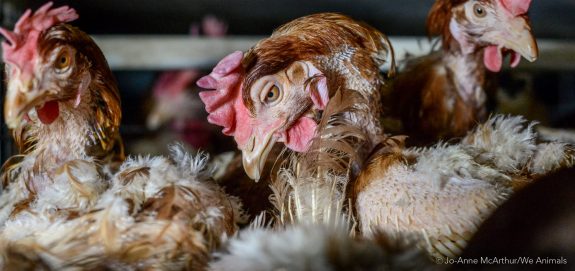The Canadian meat industry is slaughtering more animals for food than ever before, according to government slaughter statistics analyzed by Animal Justice. In 2019, over 834 million land animals were killed at the hands of the meat industry—up drastically from 750 million in 2015.
Up from 819 million in 2018, 800 million in 2017, 771 million in 2016, and 750 million in 2015.
The ongoing increase in slaughter is almost entirely due to more chickens being killed for meat. Per capita demand for most types of meat has either declined or remained relatively constant over the past 30 years. For instance, per capita pig and cow meat consumption (i.e., pork and beef) has decreased by about a third. But chicken meat consumption has more than doubled. Chickens are much smaller than cows or pigs, so more of them must be killed to sell the same amount of meat. Population growth also plays a role in the increase in chickens being slaughtered.
Here are the numbers broken down by sector:
Meat chickens: 747,506,691
Egg-laying hens and breeding chickens: 33,919,452
Turkeys: 19,804,087
Ducks and geese: 6,861,063
Pigs: 21,404,799
Adult cows (dairy and meat): 3,160,734
Calves: 210,240
Sheep and lambs: 491,146
Deer: 9,802
Elk: 1,754
Wild boars: 536,238
Bison: 9,379
Rabbits: 6,188
Goats: 86,608
TOTAL: 834,008,191
But these numbers don’t paint the full picture. At least 44,041,000 chicks were killed at hatcheries in 2019, most of them male chicks who were ground up alive because they cannot produce eggs and are worthless to egg farmers. An additional 590,000 turkey chicks were killed in turkey hatcheries.
Canada also exported 5,861,620 live cows, pigs, sheep, bison, and horses in 2019 to the United States, and 16,383,263 live chickens and other birds. Millions more animals are exported by ship and air to other countries.
Horses are also missing from this picture. The government has concealed horse slaughter stats for the last three years, as a favour to the horse meat industry, so likely tens of thousands of horses killed are not accounted for in Animal Justice’s analysis. (In 2016, the last year for which data is available, over 54,000 horses were slaughtered.)
These figures also don’t include aquatic animals like fishes, lobsters, crabs, and shellfishes whose individual deaths aren’t tracked—their lives are measured in tonnes. However, we do know that in 2019, Canada killed 143,969 tonnes of farmed finned fishes (e.g., salmon and trout), and 43,202 tonnes of shellfishes (e.g., mussels and clams), accounting for millions of individual lives. A further 727,919 tonnes of ocean finned and shelled fishes and 23,768 tonnes of freshwater fishes were killed.
Other animals killed by the meat, dairy, and egg industries outside of slaughterhouses are also not accounted for in this analysis, including the millions of animals who die prematurely of illnesses and injuries on farms or during transport, and the millions of animals who are so sick and injured that they are condemned when they arrive at slaughter.
It is not yet know how the COVID-19 pandemic will affect 2020 slaughter totals. With slaughterhouses closes due to mass infections among workers, supply chain disruptions are resulting in many farmers killing off animals whom they cannot ship to slaughter for profit. The deaths of these animals may never be reported to the government if they are not killed in slaughterhouses. Meanwhile, chicken farmers are reducing populations by hatching fewer birds. This could end up reducing the number of chickens killed for food in Canada in 2020.
Source: Canadian agri-food sector intelligence
Photo courtesy of Jo-Anne McArthur / We Animals
Join the Animal Justice mailing list






